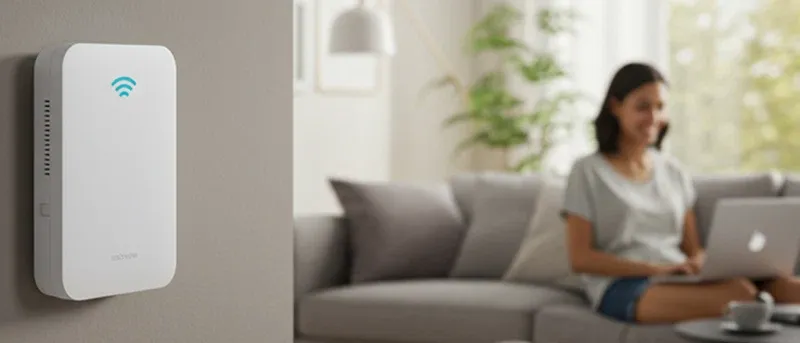
How to boost your Wi-Fi signal using a Wi-Fi extender
A strong and reliable Wi-Fi connection is essential for seamless browsing, streaming, and working from home. However, dead zones and weak signals can cause frustration, especially in larger homes or spaces with thick walls. One effective solution to this problem is using a Wi-Fi extender. In this blog post, we’ll cover what a Wi-Fi extender is and whether these wireless internet boosters really work.
What is a Wi-Fi extender?
A Wi-Fi extender, also known as a Wi-Fi repeater or range extender, is a device designed to enhance the coverage of your existing wireless network. It captures the Wi-Fi signal from your router and retransmits it to areas where the signal is weak or nonexistent.
Wi-Fi extenders come in these different types.
- Plug-in extenders: Small devices that plug directly into an electrical outlet and boost signal range.
- Desktop extenders: Larger units with more powerful antennas that sit on a flat surface for broader coverage.
- Mesh Wi-Fi systems: A more advanced option that replaces your router with multiple nodes, providing seamless coverage across your home.
Placing a Wi-Fi extender strategically between your router and the problem area can significantly improve wireless connectivity in hard-to-reach spots.
Can a Wi-Fi extender boost signal?
Yes, a Wi-Fi extender can help boost your signal, but it does not increase your internet speed. Instead, it extends the coverage of your existing Wi-Fi network, making it accessible in areas where the signal was previously weak or non-existent.
The benefits of using a Wi-Fi extender include the following.
- Eliminates dead zones: A Wi-Fi extender can cover areas your router’s signal struggles to reach.
- Improves connectivity for smart devices: Devices such as smart TVs, security cameras, and gaming consoles can benefit from extended coverage.
- Enhances flexibility: You can work or stream from any room in your home without worrying about weak signals.
When using a Wi-Fi extender, you should consider the following factors.
- Placement is crucial: Positioning your extender too far from your router can result in a weak extended signal. Place it halfway between the router and the area needing coverage.
- Network speed may be affected: Some extenders may reduce bandwidth slightly since they rebroadcast the existing signal.
- Compatibility with your router: Ensure your extender supports your router’s frequency bands (2.4 GHz and/or 5 GHz) for optimal performance.
How to tell if you need a Wi-Fi extender/booster
If you’re experiencing slow speeds or dead zones in your home, you might need a Wi-Fi extender or booster. Here are some signs that indicate it’s time to consider one.
- Frequent buffering or dropped connections: If your streaming services constantly lag or your video calls drop, your Wi-Fi signal may be too weak in certain areas.
- Slow speeds in specific rooms: If your internet works well near the router but slows down in other areas, an extender can help distribute the signal more evenly.
- Devices struggling to stay connected: Smart home devices, gaming consoles, or security cameras may have trouble staying online if your Wi-Fi signal doesn’t reach them reliably.
- Large or multi-story home: If your home has multiple floors or thick walls, a Wi-Fi extender booster can help cover hard-to-reach spots.
If any of these issues sound familiar, a Wi-Fi extender booster could be the solution to improve your internet experience.
Best practices for setting up a Wi-Fi extender
Follow these best practices to get the best performance from your Wi-Fi extender.
- Optimal placement: Position your extender halfway between your router and the area with poor signal for the best coverage.
- Avoiding interference: Keep the extender away from thick walls, metal objects, and electronic devices that can cause signal disruption.
- Connecting to the correct network: Ensure your devices connect to the extender’s network if it has a different name from your primary router.
- Regular firmware updates: Keeping your extender’s firmware updated can improve its performance and security.
- Using the correct frequency band: If your extender supports both 2.4 GHz and 5 GHz, use the appropriate band based on distance and speed needs.
Wi-Fi extender alternatives
Other options are available if a Wi-Fi extender doesn’t solve your connectivity issues.
- Upgrading to a mesh Wi-Fi system: Mesh systems provide seamless coverage using multiple nodes, making them an excellent option for large homes.
- Wired solutions (Ethernet & powerline adapters): Running an Ethernet cable to weak signal areas or using powerline adapters can provide a stable wired connection.
- Upgrading your router: If your router is outdated, investing in a newer model with better range and faster speeds may be a more effective solution.
Should I use a Wi-Fi extender in my home?
If you experience Wi-Fi dead zones in your home, a Wi-Fi extender can be an effective and affordable solution to enhance coverage. By selecting the correct type of extender and placing it strategically, you can enjoy a stronger and more reliable internet connection throughout your space. Consider a high-quality Wi-Fi extender compatible with your router and internet speed for the best results.
Looking for more ways to improve your home internet experience? Check out Brightspeed Wi-Fi extenders and more to ensure you get the best performance possible!